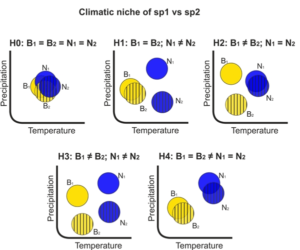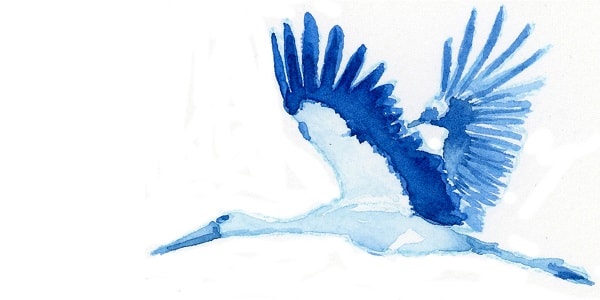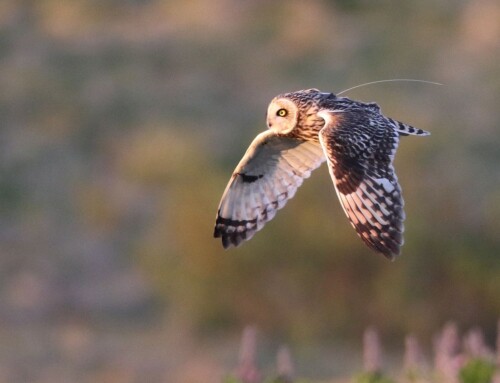LINKED PAPER
Seasonal climatic niches diverge in migratory birds. Ponti, R., Arcones, A., Ferrer, X. & Vieites, D.R. 2019. IBIS. DOI: 10.1111/ibi.12784. VIEW
Migratory birds make great journeys from one part of the planet to another. This implies that those species are exposed to very different environmental conditions in their breeding and non-breeding ranges. Although some migratory birds could occupy different habitats and change their diet during their breeding or non-breeding season, little is known about the climate they experience in both ranges. Do migratory birds follow the same climatic conditions across both seasonal ranges? Or, do they shift their climatic niche completely?
To study these differences between seasons, we explored the climatic niche for the breeding and non-breeding ranges of 355 Eurasian-African migratory birds. This included all short- and long-distance migratory species of various families, from passerines (Passeriformes) to eagles (Accipitridae), in order to look for general patterns related with migratory behaviour and main life history traits.
We found that over 80% of species do not present similarities in their climatic conditions during the breeding and non-breeding periods (Fig. 1). This difference is related with the distance that migratory birds travel, as those species that perform longer journeys experience more different climatic conditions between seasons than short-distance migrants. In fact, the species with the greatest climatic differences were some species of arctic waders (family Scolopacidae), which breed in arctic areas of Eurasia and winter in tropical and subtropical areas of Africa. These results suggest that migratory species do not track certain climatic conditions, but instead have a wider climatic niche than what could be observed by focusing only in their breeding or non-breeding period. Although some differences were found between families, there is a general pattern of switching climatic conditions shared by all groups. For example, most sandpipers and allies (family Scolopacidae) represent the species with climates more divergent in their breeding and wintering ranges. By contrast, herons (family Ardeidae) that migrate less and occupy similar habitats during both breeding and non-breeding season, represent the group with more climatic similarities in both ranges.

Figure 1 Alternative hypotheses when comparing both seasonal climatic niches of one species and two sister species. Above, the distribution range of a migratory bird species. The breeding range [B] is in yellow (light) and the non-breeding range [N] is in blue (dark). Below, two alternative hypotheses of the climatic niche of a migratory bird species are represented in the climatic space. The yellow and blue circles correspond to the climatic niche of the breeding and non-breeding ranges respectively. Hypothesis 0 (H0) represents similar seasonal climatic niches, and hypothesis 1 (H1) different seasonal climatic niches
Furthermore, multiple phylogenetically related species present similar ecological niches. This led us to ask ourselves whether sister (or very closed related) migratory bird species also display similar climatic conditions between their breeding ranges and between their non-breeding ranges. Accordingly, we hypothesized different scenarios (Fig. 2): The first possibilities are that the climate of all breeding ranges and non-breeding ranges of sister species were similar (H0), or different between each other (H3). Sister migratory species could, however, share similar climatic conditions only in their breeding ranges (H1) or only on their non-breeding ranges (H2). Finally breeding and non-breeding climatic niches of sister species could be similar but not within each species (H4). Globally, we found most cases corresponding to the H1 and H4 scenarios. This suggested that there is a higher niche conservatism in their breeding ranges, probably due to the specific environmental requirements that birds have during their breeding season.
 Figure 2 Five alternative hypotheses comparing breeding and non-breeding climatic niches of two sister species. H0: all climatic niches similar; H1: only breeding climatic niches similar; H2: only non-breeding climatic niches similar; H3: all climatic niches different; H4: similar breeding and non-breeding climatic niches but different intraspecific niches
Figure 2 Five alternative hypotheses comparing breeding and non-breeding climatic niches of two sister species. H0: all climatic niches similar; H1: only breeding climatic niches similar; H2: only non-breeding climatic niches similar; H3: all climatic niches different; H4: similar breeding and non-breeding climatic niches but different intraspecific niches
Our findings highlight that migratory birds do not move tracking specific climatic conditions, suggesting that are other drivers, like the resource availability, that could be a bigger role (Ponti et al. 2018). Furthermore, it is important to consider both the breeding and non-breeding environmental niche of migratory species when studying those species, as notable differences are reported in terms of climate on both ranges.
Nominate this article for a BOU Science Communication Award.
References
Ponti, R., Arcones, A., Ferrer, X. & Vieites, D.R. 2019. Seasonal climatic niches diverge in migratory birds. IBIS. DOI: 10.1111/ibi.12784. VIEW
Ponti, R., Arcones, A., Ferrer, X. & Vieites, D.R. 2018. Productivity as the main factor correlating with migratory behaviour in the evolutionary history of warblers. Journal of Zoology 306: 197-206. VIEW
Image credit
Featured image: Illustration of a White Stork, Ciconia ciconia © Made by Giuliana Ponti




